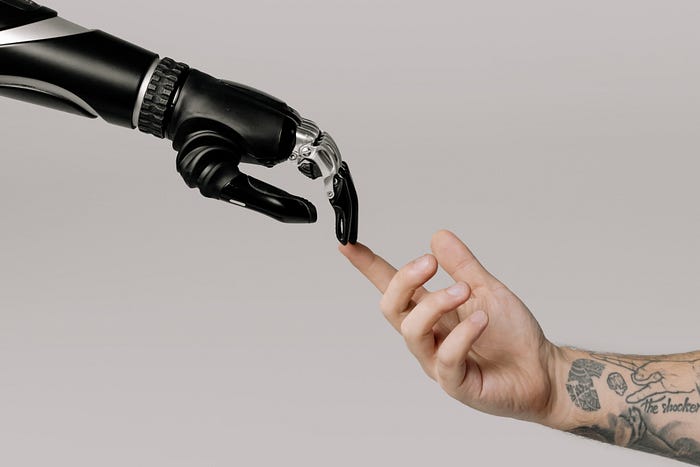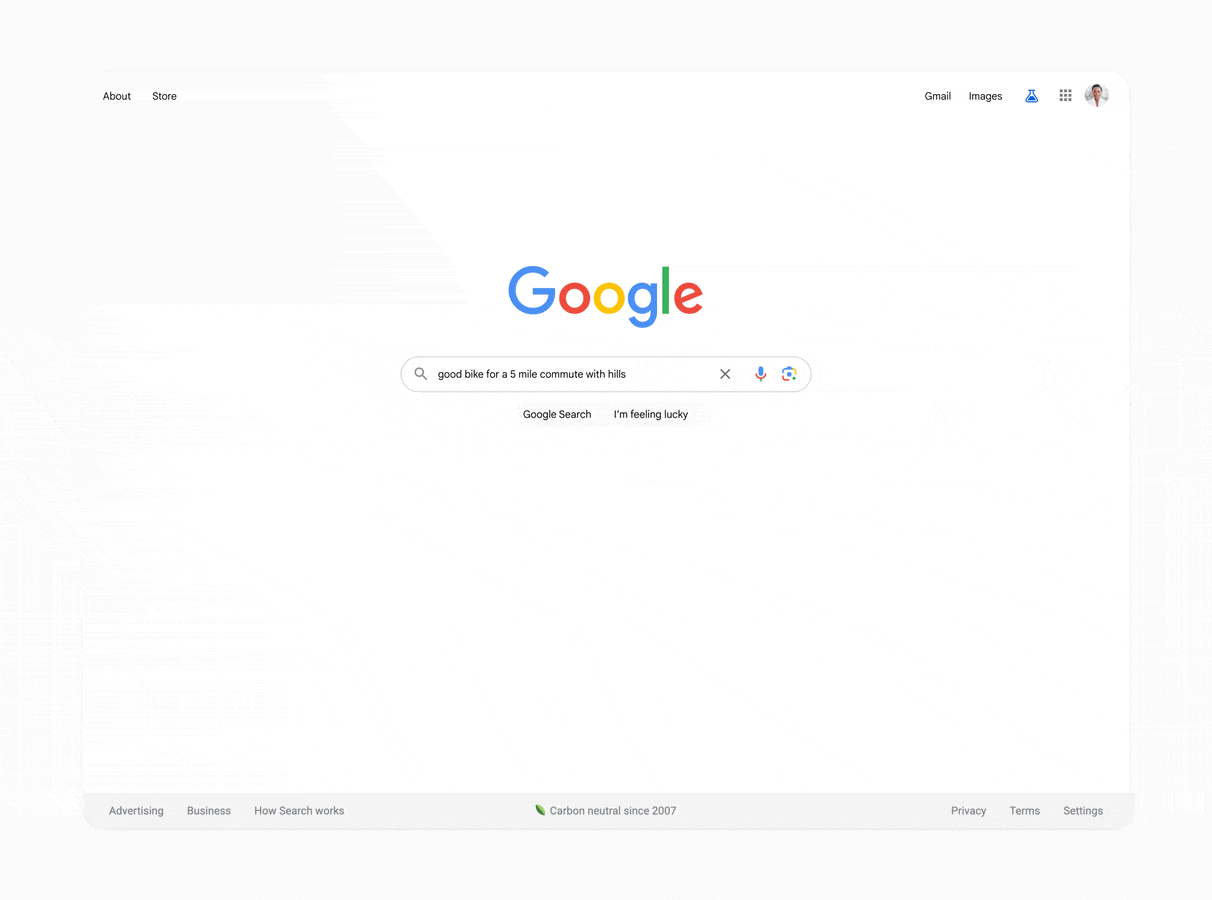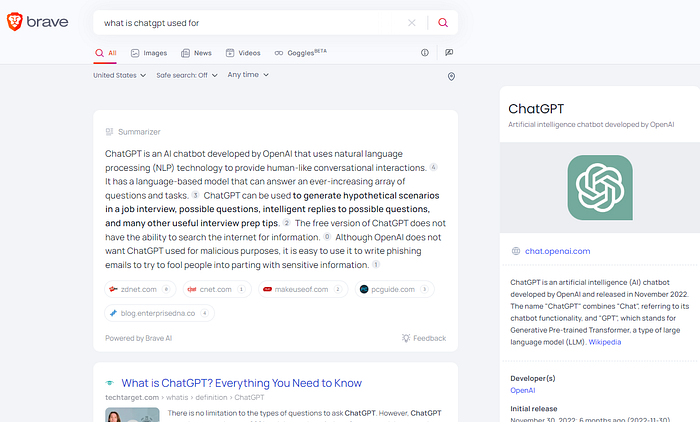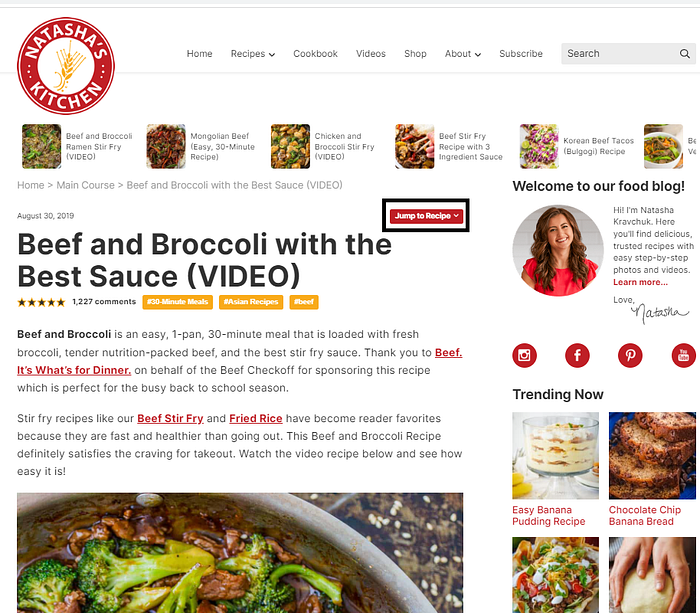

Why UX Research has a bright future in the age of AI
source link: https://uxdesign.cc/why-ux-research-has-a-bright-future-in-the-age-of-ai-97b756f3fe97
Go to the source link to view the article. You can view the picture content, updated content and better typesetting reading experience. If the link is broken, please click the button below to view the snapshot at that time.
Why UX Research has a bright future in the age of AI
Organizations can’t fail faster, so now they might finally focus on user-centered design

Photo by cottonbro studio: https://www.pexels.com/photo/bionic-hand-and-human-hand-finger-pointing-6153354/
AI will likely cause a resurgence in User-Centered Design, as Silicon Valley's favorite phrase, "fail fast and fail often," is becoming obsolete.
As a Designer, it's easy to be anxious about generative AI tools like ChatGPT and MidjourneyAI. But while these technologies will devalue some of our skills, UX Research and Design will increasingly have a lot of value.
This is partly because Generative AI will likely cause one of the past decade's most significant user mental model shifts.
To understand my optimism around AI, and the future many UX Researchers/Designers have, let's start with why Silicon Valley's famous phrase won't work anymore.
Now that we can’t fail faster, User Research and Product Design will help fail better
Generative AI can help you create a mediocre website in an afternoon. Here's how:
- Plan and outline your website, such as purpose, content, and structure and number of pages
- Find a website layout/template that you like, and ask ChatGPT to generate code for the website
- Provide ChatGPT prompts for marketing/writing copy, and tweak it a little bit for each of the sections
- For art assets (without paying too much), use MidJourneyAI or other available free images
- Adjust color and typography by generating color palettes, style guides, and more.
- Put the finishing touches on the website.
You could do several steps through website builders like Squarespace, Wix, and WordPress. However, the fact that now you can not only generate content for the page but also custom code allows you to build faster than ever.
In fact, this could be the fastest we could build things ever. What's more, if these websites fail, you're not likely to be that emotionally attached to them (and you can build another).
However, the fact that you can build faster than ever touches on one of the biggest mistakes people make when failing fast: you might not learn anything useful from it.
This mistake is one of the seven primary Diseases that make good products bad: Pivotitis.
Instead of failing, reflecting, and slowly iterating towards a goal, scope, and design, many companies often declare a pivot and start over, taking your company in a different direction.
However, this is often one of the reasons that 90% of startups fail: they can't find a product-market fit or enough customers to sustain themselves before they run out of money.
So, now that we've essentially reached what might be the apex of building and failing quickly, there are two choices for many companies to make:
- Build hundreds of ideas and see which ones fail or succeed, tanking your reputation in the process
- Take a moment to consider the value you bring to customers and your user's needs, and put thought into developing one valuable product.
Smart money is that organizations take the 2nd option, where UX Researchers and Product Designers can flourish. In an age when building is becoming easier and more accessible, taking extra time during discovery and research to identify the value you can bring to your users will help you design the right product.
In particular, Product Designers can provide the business with skills like Problem framing, identifying key insight moments, and more to reduce user friction around the product.
UX Research, on the other hand, can help to determine not only who the users are but utilize things like competitive analysis and Data-Informed UX Design to understand the market (and understand what value we offer users).
Doing so ensures that when it comes time to build the website, product, or service, the business has a clear idea of what they will design and build to ensure they get things (mostly) right the first time around.
However, there are other ways that Generative AI is helping the field of UX.
Generative Search and Summarizer requires good IA/UX Writing
Google recently unveiled a Generative Search Experience, which uses AI to summarize existing information you would have likely compiled after searching, clicking several links, and reading up on several sites.

https://blog.google/products/search/generative-ai-search/
However, they're not the only company to do so. Brave, another search engine, released Brave Summarizer, which serves a similar purpose. It takes several links, searches for relevant information, and compiles it with citations to provide users with a quick summary.

Brave summarizer window
This optimizes much of what you would do with the search engine, and you only need to look up a recipe to understand why.

How many times have you used the Jump to Recipe button?
What you care about, the recipe is buried under someone's life story, descriptions of everything, tips or full-page images, and more. This is a technique called ‘burying the lede’, where you hide relevant information several paragraphs down to fill the page with ads and earn you some money.
However, with these new tools, users may not even visit your site and instead rely on the AI tool to provide them with what they need. So, putting aside the ethics of potentially destroying many websites using Google Adsense, it’s going to be increasingly crucial that AI will be able to find relevant information from your site.
How many lost sales might you encounter if the summarizer couldn't provide a contact address for your product, but it did for all your competitors?
This is why good information architecture and UX writing be crucial in the future. You don't have to design for users who will click on the website: you also have to design for these AIs that scrape data.
As such, thinking about the IA and the writing you use will be crucial to ensure that users can find what they need.
That's not to mention that the core of the design will still be valuable.
Design iteration might become the bulk of our design work
I mentioned in the previous article that design priorities might shift away from concentrating heavily on the first draft and possibly more points on the second and beyond.
This is because of two fundamental points:
- You will never get a design 100% right on the first iteration
- Generative AI cannot help you with iteration because it doesn't understand why
Understanding what's good or bad about a design, why users did or did not like a particular feature, or why you should design something a certain way will become the bulk of the value we bring to businesses.
After all, if it's easier than ever to build a mediocre or crappy website, it will be precious to create a well-designed website that offers clear values to our users.
This is why understanding the “Why” of your design process, best practices, user psychology, and more, along with seeking out user feedback and incorporating it into designs, will still be a crucial skill that will be everlasting even in the age of AI.
UX research and design are still necessary for the age of AI
Cassie Kozyrkov, the chief decision scientist at Google, has highlighted that the recent explosion of AI is not because of an AI revolution: it's because of a UX revolution.
The recent advancements in AI have provided users with an easy interface for tinkering with AI, empowering voices to use it creatively and outputting valuable raw materials.
Design won't perish in the face of these fantastic tools. Of course, our priorities might shift, along with our value, but being able to provide the finished product, along with providing information that helps build these valuable raw materials, will drive businesses to take a more user-centered approach in the future.
Rather than failing fast and UX having to chase after what businesses aim for, organizations could take a step back and become more user-centered, as that help build distinguish themselves from hastily built AI-generated websites.
Kai Wong is a Senior Product Designer, Data-Informed Design Author, and Data and Design newsletter author. His new free book, The Resilient UX Professional, provides real-world advice to get your first UX job and advance your UX career.
Recommend
About Joyk
Aggregate valuable and interesting links.
Joyk means Joy of geeK